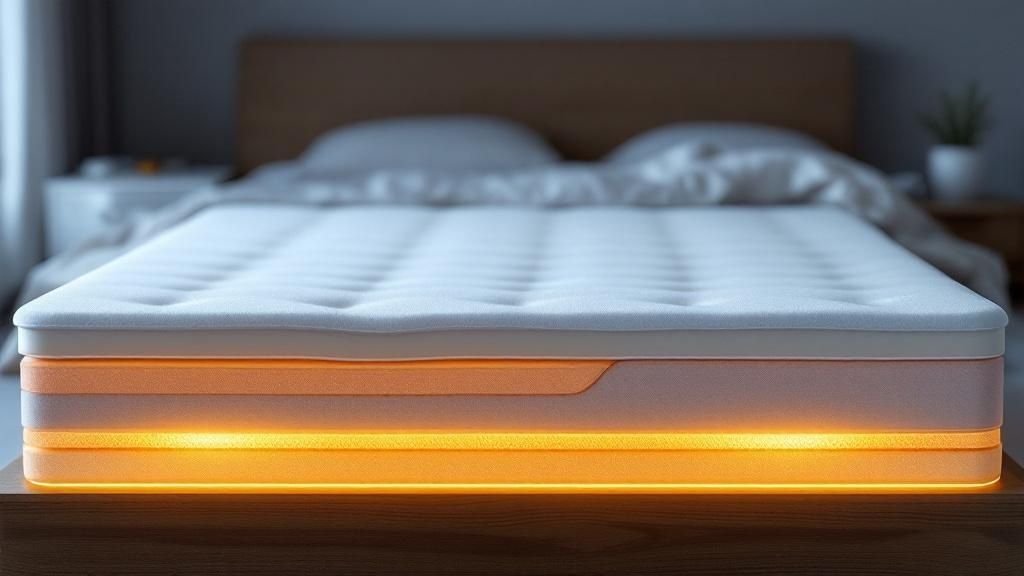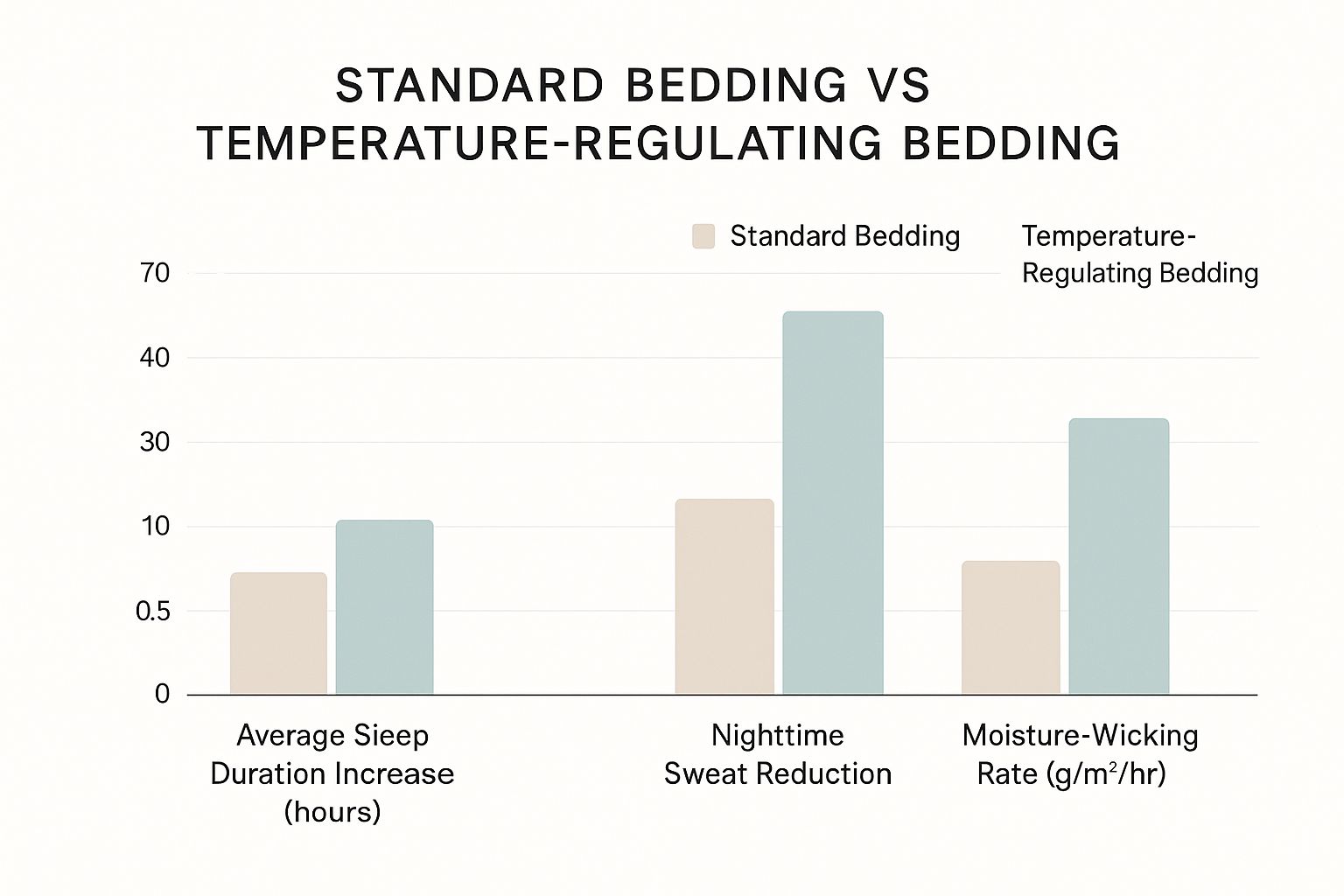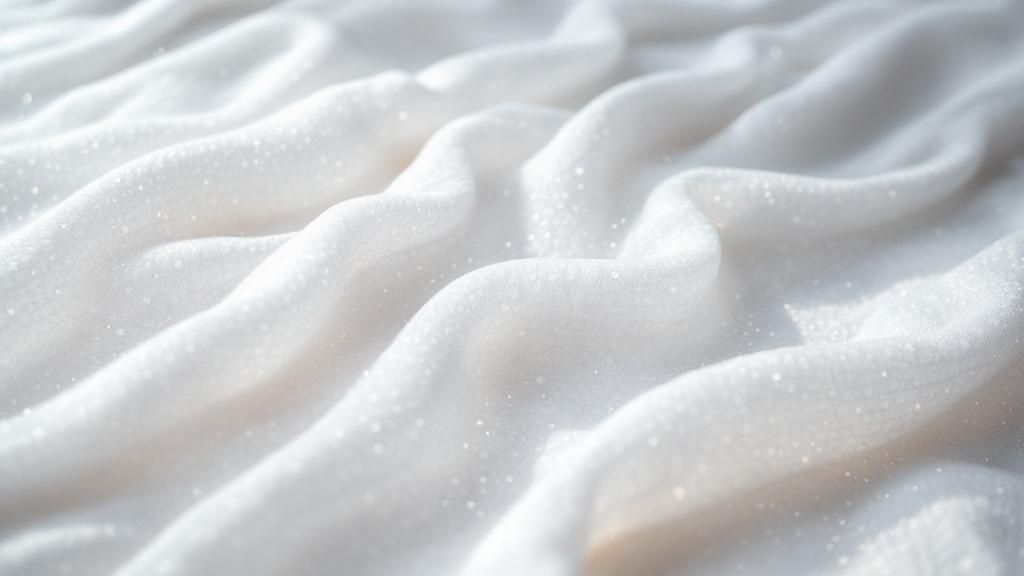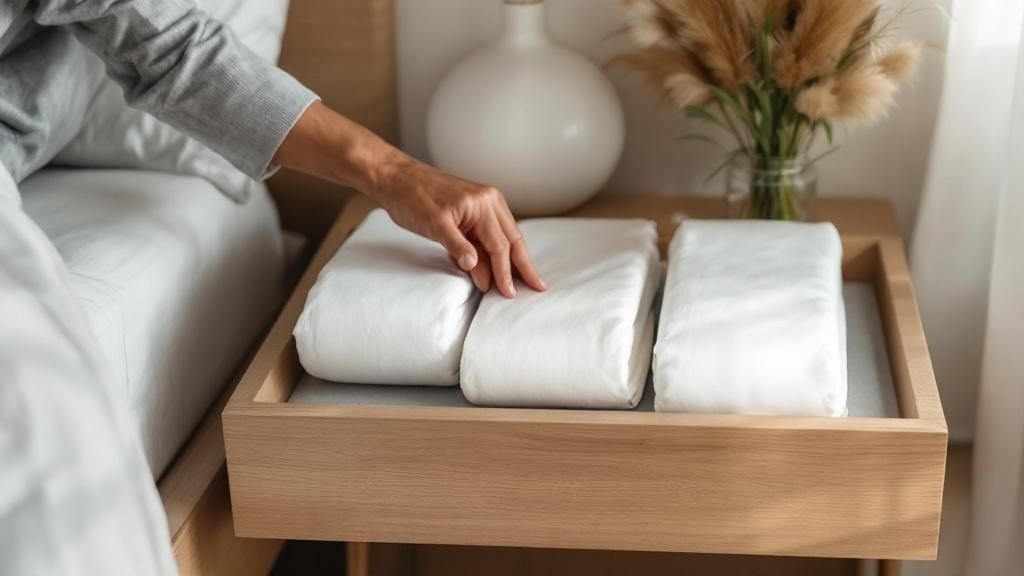We’ve all been there. Kicking off the covers in a hot flash, only to wake up an hour later shivering and pulling them back up to your chin. It’s a frustrating dance that signals your sleep temperature is all out of whack. This constant battle disrupts your natural sleep cycles and is a major reason you wake up feeling drained instead of restored.
This guide is about working with your body's own internal thermostat, not against it. Let's dig into how the right bedding can help you find that perfect, stable sleep environment.
Why Your Sleep Temperature Is So Critical for Restful Nights
We spend a lot of time thinking about mattress firmness and pillow height, but we often overlook one of the biggest players in sleep quality: temperature. To even begin to fall asleep, your core body temperature needs to drop by a couple of degrees. This is a crucial biological trigger, signaling your brain to start producing melatonin, the hormone that tells your body it's time for bed.
If your bedding is trapping heat, it’s actively fighting this natural process. You might drift off initially, but your body will spend the night struggling to cool itself down. This leads to that familiar restlessness, night sweats, and waking up over and over again. You get stuck in that loop of being too hot, throwing off the covers, and then getting too cold.
This goes beyond simple comfort—it fundamentally messes with your sleep architecture. These temperature swings can keep you from sinking into the deeper, more restorative stages of sleep, like REM and deep sleep. The result? You can spend a full eight hours in bed and still wake up feeling like you barely slept.
Common Scenarios Where Sleep Temperature Goes Wrong
Think about how often this problem shows up in real life. It’s a constant challenge for so many people.
- Couples with Different "Thermostats": This is a classic. One person is perpetually cold, bundled up like it's winter, while the other radiates heat like a personal furnace. Finding one comforter that suits both of you can feel like an impossible task.
- The Change of Seasons: That cozy duvet that felt like a warm hug in January suddenly feels like a sauna in May. You end up in a constant cycle of swapping out blankets and layers trying to keep up with the weather.
- Hormonal Changes: For many women, things like pregnancy or menopause bring on hot flashes and night sweats. These can turn the bed into a sauna, making a full, uninterrupted night of sleep feel like a distant dream.
The real secret to great sleep is creating a stable microclimate around your body. It's not just about finding "cooling" bedding; it's about finding bedding that helps you achieve a consistent, balanced temperature all night long. This supports your biological sleep process instead of disrupting it.
This is where specialized temperature regulating bedding comes in. Materials like 100% organic bamboo sheets, for example, offer a real solution by tackling the root of the problem: poor heat and moisture management.
Understanding the Science Behind Smarter Bedding

Have you ever wondered what makes some fabrics feel instantly cool and refreshing while others feel like they're trapping you in an oven? It’s not just a feeling; it’s a deliberate feat of material science. Knowing a little about the technology packed into temperature-regulating bedding can help you see exactly how it works to give you a better night's sleep.
Ultimately, it all boils down to two core principles: managing moisture and airflow, and in more advanced materials, actively managing heat itself.
Wicking Moisture and Keeping Air Flowing
Moisture-wicking fabrics in bedding operate on the same principle as your high-performance workout gear. Their job is to pull sweat and humidity away from your skin and spread it across the surface of the fabric, where it can evaporate much faster. This simple function is what stops you from waking up feeling sticky and clammy.
Breathability goes hand-in-hand with this. A breathable material allows air to move freely through the weave, which lets your body heat escape instead of building up under the blankets. Natural fibers are often fantastic at this. For example, bamboo is celebrated for its incredible breathability. The unique structure of bamboo fibers is a big reason why—you can dive deeper into this in our guide on bamboo sheets being a cool and eco-friendly choice.
This shift toward smarter textiles isn't a small trend. It's fueling huge growth in the sleep industry, with the global home bedding market expected to hit an incredible USD 249.62 billion by 2035. This growth is almost entirely driven by people like you demanding better comfort and performance from their bedding.
The best temperature-regulating bedding doesn't just feel cool when you first climb into bed. It works all night long to manage the heat and moisture your body naturally produces, creating a perfectly balanced environment for deep, uninterrupted rest.
Active Heat Management With Phase-Change Materials
Moving beyond the properties of natural fibers, some of the most sophisticated temperature-regulating bedding incorporates something called Phase-Change Materials, or PCMs. Think of these as microscopic thermostats woven directly into the fabric.
These tiny, intelligent microcapsules absorb and release heat to keep your temperature stable. Here's a breakdown of how they work:
- When you get too hot: The PCMs absorb your excess body heat. This energy causes the material inside the capsules to change from a solid to a liquid, effectively storing the heat.
- When you start to cool down: The process reverses. The PCMs release their stored heat as they transition back from a liquid to a solid state, gently warming you up.
This constant, dynamic process creates an active buffer against temperature fluctuations, keeping you squarely in that "just right" comfort zone all night long. It’s a game-changer for anyone who struggles with sleeping too hot or too cold.
How to Choose the Right Material for Your Sleep Needs
Picking the right fabric for your bedding is probably the single most important decision you'll make in the quest for a comfortable night's sleep. The world of temperature regulating bedding is vast, and what works wonders for a friend who's always hot might leave you shivering. It all comes down to your personal sleep style.
The trick is to match a fabric's natural strengths to what your body actually does at night. Let's dig into how you can find the perfect material for you.
For Hot Sleepers Who Need to Cool Down
If you're constantly kicking off the covers or waking up feeling clammy, you need a material that does two things exceptionally well: breathe and wick away moisture. Your mission is to find fabrics that actively pull heat and sweat away from your body, letting it evaporate instead of building up.
- Bamboo Viscose: This stuff is famous for its silky-smooth, cool-to-the-touch feel. Bamboo fibers are incredibly breathable and fantastic at wicking moisture off your skin, keeping you comfortably dry all night.
- Tencel™ Lyocell: A close cousin to bamboo, Tencel is another plant-based hero known for its impressive moisture control. It feels cool against the skin from the moment you slip into bed and is a great choice if you have sensitive skin.
- Linen: A timeless classic for a reason. Linen's naturally looser weave allows for incredible airflow, which is a lifesaver on warm nights. It has a more textured feel than bamboo, but its ability to stay cool and get softer with every wash makes it a top contender.
For Cold Sleepers Seeking Cozy Warmth
Are you the one who's always reaching for an extra blanket? If you find yourself shivering, you need bedding that insulates you without trapping moisture. The goal is cozy warmth that still breathes, so you don't end up overheating and sweating halfway through the night.
- Wool: Don't sleep on wool—it’s a true temperature-regulating superstar. It’s a natural insulator that creates a pocket of warm air, but it also wicks moisture away brilliantly. This means you stay warm and dry, never clammy.
- Flannel: A high-quality brushed cotton or wool flannel provides serious coziness. Just be sure to look for well-made, breathable options. Cheaper synthetic flannels can feel more like a sauna, which defeats the purpose.
To help you visualize the differences, here’s a quick comparison of some of the most popular materials out there. This table breaks down their key features to guide you, whether you're battling the heat, seeking warmth, or prioritizing sustainability in your bedding choices.
Comparing Popular Temperature Regulating Bedding Materials
| Material | Best For | Breathability | Moisture-Wicking | Feel |
|---|---|---|---|---|
| Bamboo Viscose | Hot sleepers, sensitive skin | High | Excellent | Silky, smooth, cool |
| Tencel™ Lyocell | Hot sleepers, eco-conscious | High | Excellent | Very soft, cool to the touch |
| Linen | Hot sleepers, classic style | Very High | Good | Crisp, textured, softens over time |
| Wool | Cold sleepers, all-season use | Moderate | Excellent | Soft, cozy, not scratchy (in bedding) |
| Flannel (Cotton) | Cold sleepers, winter use | Moderate | Fair | Very soft, fuzzy, warm |
As you can see, each material offers a unique combination of benefits. Choosing the right one is about aligning these properties with your personal comfort needs.
This data really drives home how specialized bedding can transform your sleep quality by managing your body's immediate environment, often called its "microclimate."

As this infographic shows, the right materials lead directly to less sweat, better moisture management, and ultimately, longer and more restorative sleep.
Your choice of fabric can absolutely make or break your sleep. Stop focusing only on thread count and start prioritizing how a material actually handles heat and moisture based on your body’s needs.
This shift toward performance and wellness is a big reason why the home bedding market is projected to grow to USD 232.31 billion by 2034. People are catching on, choosing materials like organic bamboo not just for comfort but for their health and eco-friendly advantages, too.
If you want to compare specific products and get more in-depth reviews, check out our guide on the best temperature regulating sheets to find your perfect match. Making an informed choice is your first, and most important, step toward finally achieving balanced, restful nights.
Creating a Complete Temperature-Balanced Sleep System

If you're tired of tossing and turning because you're too hot or too cold, you've probably realized that great sleep isn't about finding one magic product. The real secret to conquering those nighttime temperature swings lies in creating a complete sleep system where every single layer works together. It’s a holistic approach, and it’s what finally delivers consistent comfort.
Most people overlook the very foundation of their bed: the mattress protector. It’s a classic mistake. You can invest in the best cooling sheets in the world, but if your mattress protector is a cheap, plastic-like barrier, you’ve just trapped all the heat and moisture right where you don't want it. Instead, look for protectors made with breathable, cooling fabrics that allow air to flow freely.
Building Your Layers for All-Season Comfort
With a breathable foundation in place, you can start strategically layering for year-round comfort. This is where you can really dial things in to match your personal sleep style. A fantastic combination I often recommend is pairing a high-performance sheet set with a breathable mattress topper.
Think about it: a topper made from ventilated latex or a modern gel-infused foam creates a cooling buffer zone between your body and the mattress itself. Add a set of moisture-wicking bamboo sheets on top of that, and you've got a powerful duo that actively pulls heat and sweat away from you all night long.
Don't forget your pillow. Your head releases a significant amount of body heat, so a hot pillow can ruin your night. Pillows filled with materials like shredded latex, buckwheat, or cooling gel foam allow for much better airflow than a dense, solid block of memory foam. No more flipping the pillow to find the cool side.
The goal is to build a sleep system where no single layer sabotages another. A breathable duvet can't do its job if it's sitting on top of a heat-trapping mattress protector and non-breathing sheets.
Finally, let's talk about the top layer—your duvet or comforter. Opting for a fill like natural down, wool, or silk gives you incredible all-season performance. These natural materials are masters of both insulation and breathability, keeping you perfectly warm in the winter without causing you to overheat in the summer.
This focus on building a better sleep environment is part of a much larger consumer trend toward health and wellness. People are investing more in their sleep, which is why the home bedding market is projected to reach $151.45 billion by 2029. If you're interested, you can dig deeper into these market trends and consumer behaviors on ResearchAndMarkets.com.
How to Care for Bedding to Maximize Its Performance

You've made the investment in top-notch temperature regulating bedding, which is a great first step. Now, let's make sure you get the most out of it for years to come. Proper care is what keeps these advanced fabrics working their magic, so you can continue to enjoy that perfect sleep temperature.
Think of fabrics like bamboo or Tencel™ as the high-performance gear of the bedding world. You wouldn't throw your best athletic apparel in a hot wash cycle and expect it to perform the same, right? The same logic applies here. High heat is the primary culprit that can damage the delicate fibers responsible for wicking away moisture and keeping you cool.
To keep them in prime condition, always stick to a cool, gentle wash cycle. Use a mild, liquid detergent, as harsh powders can be abrasive. This simple step cleans everything beautifully without stressing the fibers, which is what leads to pilling and a loss of their temperature-regulating abilities. For more detailed instructions, you can learn how to care for your bamboo sheets and maintain that silky-soft feel.
Drying and Storing for Longevity
When it's time to dry, remember that less heat is always better. The absolute best approach is to line-dry your bedding. It's gentle on the fabric, saves energy, and leaves your sheets with a natural freshness. If you're short on time or space and need to use a machine, be sure to select the lowest heat or a tumble-dry setting. Pull them out as soon as they're done to prevent over-drying.
Your bedding's performance is directly tied to how you care for it. Gentle washing and low-heat drying are not just suggestions—they are requirements for preserving the technology you paid for.
Don't forget that not everything needs a full wash every time. For items like a wool comforter, simply airing it out on a dry, sunny day can work wonders. The fresh air helps the natural fibers release any trapped moisture or odors, leaving it feeling and smelling refreshed without a trip through the washer.
When it's time to put away seasonal bedding, how you store it matters.
- Use breathable containers: Cotton bags or other breathable storage bins are your best friend. Steer clear of plastic containers, as they can trap moisture and create a breeding ground for mildew.
- Keep them in a cool, dry place: A well-ventilated linen closet is perfect. Try to avoid attics or basements where big swings in temperature and humidity can do more harm than good.
Common Questions About Temperature Regulating Bedding
Upgrading to temperature regulating bedding is a big step toward better sleep, so it's only natural to have a few questions before you dive in. It’s an investment, after all. Let's clear up some of the most common things people wonder about so you can feel great about your choice.
A big one I hear all the time is whether these products can really work for both hot and cold sleepers. The short answer is yes, but the magic is all in the material you pick.
Fabrics like bamboo viscose are superstars at cooling. They pull moisture away from your skin and let air flow freely, which is a lifesaver if you tend to overheat at night. On the other hand, natural insulators like wool are amazing at adapting. They’ll trap air to keep you warm when it's chilly but are still breathable enough to stop you from getting too hot in the summer. It really comes down to knowing what you need most—cooling, warming, or a bit of both—and choosing the right fabric for the job.
Is This Bedding Worth the Higher Price Tag?
Let’s be honest: high-performance bedding usually costs more upfront than your standard cotton or polyester sheets. But I encourage you to think of it less as an expense and more as a long-term investment in your health.
The reality is that the advanced fibers and quality construction make these products far more durable. They'll often outlast cheaper sets, saving you replacement costs down the road. Plus, with the market growing, there are more great options available at different price points than ever before. When you factor in the incredible impact a good night's sleep has on your energy, mood, and overall well-being, the value is undeniable.
My biggest piece of advice? Don't fall for vague marketing claims like "cool-touch." Real performance comes from proven materials. Look for specifics like Tencel™ Lyocell, silk, wool, or 100% bamboo viscose on the label.
Another smart move is to check for certifications like OEKO-TEX, which ensures the fabric is free from harmful chemicals. I also always recommend reading reviews from people who specifically talk about how the bedding performed for their body temperature. This kind of real-world feedback is the best way to know if a product truly lives up to its promises.
Ready to feel the difference for yourself? Bamtek offers 100% organic bamboo bedding engineered for incredible comfort and temperature balance. Discover our full collection of eco-friendly, OEKO-TEX certified sheets and comforters at bamtekhome.com.










